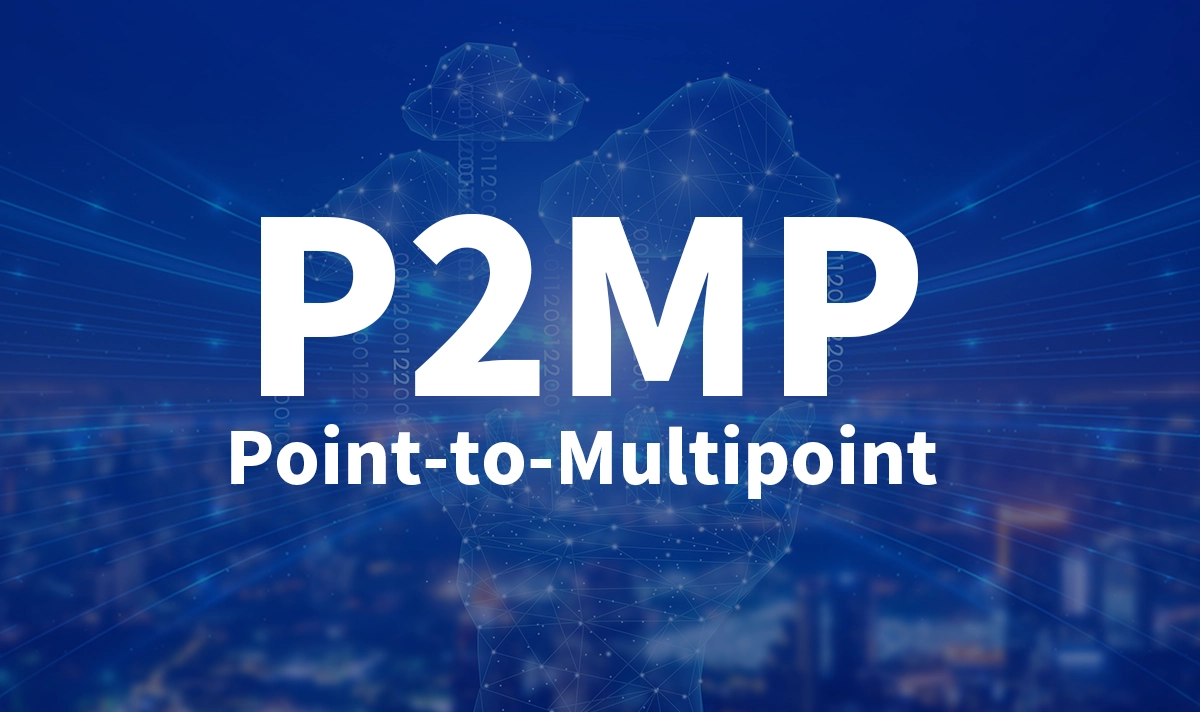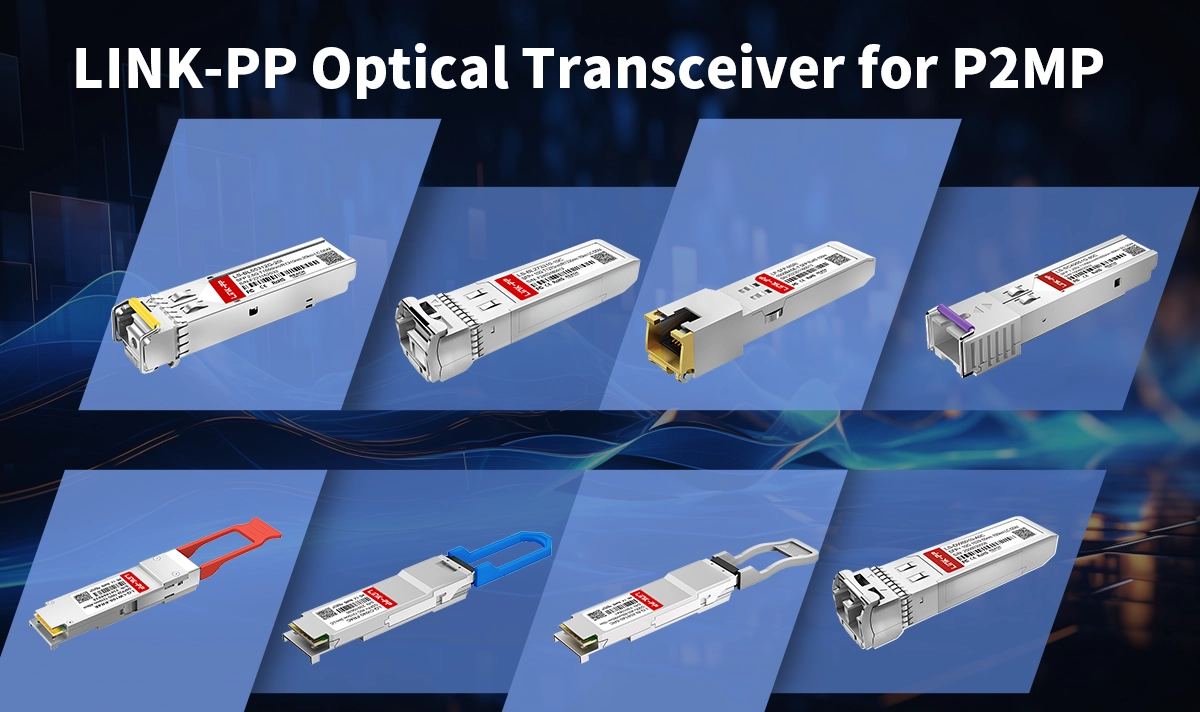🌐 Point-to-Multipoint Definition

▷ What is P2MP?
In telecommunications, the term point‑to‑multipoint (P2MP) refers to a one‑to‑many connection topology: a root station (or central node) communicates with multiple leaf stations.
In a P2MP model, the root transmits downstream to many leaves via a shared medium (e.g., a trunk with branches), and the leaves may send data upstream to the root, but typically not to each other.
▷ P2MP vs P2P: How they differ
By contrast, point‑to‑point (P2P) is a one‑to‑one link between endpoints.
P2MP supports an efficient footprint when a single source needs to serve multiple destinations—especially in access, metro, or broadcast contexts—whereas P2P offers dedicated link performance and isolation.
▷ Terminology and standard references
‑ The root node is sometimes called the ingress or hub, and leaf nodes or egress points.
‑ In the MPLS traffic engineering context, a P2MP LSP (label‑switched path) must support scalable branching, grafting, and pruning of leaves.
‑ In optical network literature, P2MP can refer to passive optical networks (PONs) or active split architectures where a single fibre path branches to multiple endpoints.
🌐 Working Principle of P2MP in Optical Networks
Basic architecture
In an optical‑based P2MP network, a central transmitter (for example, at an Optical Line Terminal – OLT) sends optical signals through a trunk fibre, then via passive splitters or active branching to multiple Optical Network Units (ONUs) or Remote Nodes. The downstream path is shared; upstream traffic is managed to avoid collisions (via time‑division multiplexing, wavelength sharing, etc.).
Shared media and branching
A key feature of P2MP is the shared medium: downstream may use a single wavelength or frequency that is broadcast to all leaves; upstream traffic typically uses the same or common channel but is managed via scheduling.
In optical P2MP, passive optical networks (PON) are a good example: one fibre from the OLT is split passively (1:N) to many ONUs in the field.
Optical implementation – coherent P2MP, PONs, next‑gen
Recent research highlights that coherent optics is being adapted for P2MP architectures—optimizing cost, spectrum usage, and latency.
For example, a study shows that P2MP optics can reduce transceiver cost, spectrum consumption, and the number of IP hops compared to P2P in metro ring networks.
Another study addresses flexible optical transceivers for P2MP upstream PONs, tackling challenges like high peak‐to‐average power ratios.
Key technical parameters and design considerations
Important parameters for P2MP optical networks include:
Split ratio (e.g., 1:32, 1:64) in passive splits
Link budget (optical power, losses from splitter, fibre attenuation)
Wavelength plan (shared wavelength downstream, upstream channel(s))
Branching architecture and distance reach
Upstream access control (TDMA, WDM, etc.)
Optical transceiver compatibility (wavelength, reach, form factor)
For example, a 20 km upstream IMDD PON study shows how advanced P2MP flexible transceivers perform over SMF.
🌐 Applications of P2MP Networks
1. Telecom Access / FTTx
In Fibre‑to‑the‑Home (FTTH) deployments, an OLT sends signals to many subscriber ONUs in a tree structure: classic P2MP. The cost efficiency of one fibre servicing many endpoints is a key driver.
2. Metro and Ring Networks
In metro ring or hub‐and‐spoke topology optical networks, P2MP can be used to serve multiple metro nodes from a central hub with branching light‑trees, reducing cost compared to many individual P2P links.
3. Wireless and Fixed Wireless Access
Even in wireless networks, the P2MP topology appears: A base station serves multiple subscriber units, rather than dedicated links for each.
4. Data Centre / Enterprise Aggregation
Within data centres or campus networks, P2MP may be applied where one central switch or distribution node connects to many edge nodes, especially when combined with optical splitters or multiplexers to save fibre or optics cost.
🌐 Advantages and Challenges of P2MP
Advantages
Cost efficiency: Serving multiple endpoints from one central node via shared trunk and branching significantly reduces fibre and transceiver count compared to many discrete P2P links. For instance, research shows transceiver and spectrum cost savings in P2MP optical solutions.
Scalability: The root can branch to many leaves; adding leaves often requires minimal additional infrastructure.
Simplified infrastructure: A unified architecture can reduce equipment footprint, cabling complexity, and maintenance.
Optimal utilisation of bandwidth: Shared downstream paths may reduce idle capacity compared to dedicated P2P links.
Challenges
Shared media limitations: Because the downstream is common to many leaves, individual link performance may be impacted by splitting losses or contention if the upstream is not well managed.
Upstream scheduling/branch control: Leaves cannot typically talk to each other; upstream traffic must be controlled (e.g., TDMA, WDM) to avoid collisions.
Branch loss and reach trade‑offs: Longer reach and higher split counts reduce optical power margins; fibre attenuation, splitter loss, and branching design must be carefully engineered.
Flexibility and future upgrades: Some legacy P2MP architectures may find upgrades (to higher speeds or coherent optics) more complex than simple P2P links. However, emerging work in coherent P2MP addresses that.
🌐 Role of Optical Modules in P2MP Deployments

● Why transceivers matter
In any optical network, the transceiver is the bridge between electrical signals in network equipment and optical signals over fibre. For P2MP networks, selecting the right optical module is critical to meet reach, wavelength, bandwidth, multiplexing, and branching requirements.
● LINK‑PP’s optical modules for P2MP‑friendly networks
LINK‑PP offers an extensive portfolio of optical transceivers and SFP modules supporting data rates from 1G to 400G (and beyond) for both single‑mode and multi‑mode fibre environments.
Some specifics:
1 G SFP modules: up to 120 km SMF reach, compatible with many vendor platforms.
10/25/40/100 G modules: e.g., support LR, SR, CWDM/DWDM variants – covering access, aggregation, and backbone use cases.
100 G QSFP28 and SFP‑DD modules optimised for density, cost, and high‑performance deployments.
For a P2MP deployment, you might choose a single‑mode long‑reach SFP/SFP+ downstream from OLT to splitter, then suitable modules at ONUs/leaves for lower reach. LINK‑PP modules support DOM (digital optical monitoring), hot‑plug, and vendor‑compatible interoperability.
● Best practices for selecting optical modules in P2MP
Match the data rate (e.g., 10G, 25G) required by the root and leaves.
Choose appropriate reach: e.g., if trunk plus branching reach is 20 km, use a module rated for that distance with the margin.
Consider wavelength plan: downstream may use one wavelength, leaves may share upstream or have distinct channels; ensure transceiver supports the needed wavelengths.
Factor in splitter losses and optic budget: for passive split ratios of 1:32 or 1:64, include ~13‑18 dB splitting loss plus fibre attenuation.
Opt for modules supporting diagnostics (DOM) for proactive monitoring and network reliability.
Future‑proof: Choose modules and form‑factors (SFP28, QSFP28) that allow upgrade to higher data‑rates or advanced architectures (e.g., coherent P2MP).
🌐 Design Considerations & Deployment Guidelines
Topology: Tree vs Ring vs Hub‑Spoke
When planning P2MP, the physical and logical branching matter. For access networks, a tree with trunk fibre from the central node and passive splitters is typical. In metro networks, light‑trees may branch to ring or hub nodes. Research shows that tree/branch networks with P2MP optics deliver cost savings.
Split Ratios, Optical Budget & Reach
Calculate optical budget: transmitter power minus splitter and fibre losses must exceed receiver sensitivity with a margin. For example, a 1:32 split may impose ~15 dB splitter loss, plus typical fibre attenuation of 0.35 dB/km (SMF) and connector/splice losses.
Ensure the chosen LINK‑PP module at the root supports required optical power and leaves support sensitivity and DOM diagnostics.
Upstream Access Mechanisms
In P2MP, upstream traffic from multiple leaves must be managed. Common mechanisms: TDMA, WDM, or time‑sliced upstream bursts (in PONs). The selection of optical modules and OLT/ONU design must support this.
Coherent vs IMDD, Future‑Proofing
Emerging P2MP architectures use coherent optics to support higher speeds and longer reach with branching. For example, coherent P2MP reduces transceiver cost and spectrum compared to equivalent P2P.
Operators and network designers should evaluate optical module readiness: form‑factor, modulation format, monitoring support, and upgrade path.
Reliability, Monitoring & Maintenance
Because one root may serve many leaves, failures or sub‑optimal performance can impact many endpoints. Features such as DOM, hot‑plug, vendor interoperability, and robust system design (including redundancy) are critical. LINK‑PP modules with DDM/DOM and broad compatibility help in that regard.
🌐 Summary & Takeaways
To summarise:
P2MP is a powerful network topology that supports one‑to‑many connectivity, well-suited to access, metro, and aggregation networks.
Optical P2MP networks provide cost, fibre‐usage, and scalability benefits when properly architected.
Key considerations include optical budget, branching/split design, upstream access control, reach, transceiver compatibility, and future upgrade paths (e.g., coherent optics).
Optical modules are fundamental to meeting these requirements; selecting vendor‐agnostic, standards‐compliant modules with monitoring capability is essential.
LINK‑PP offers a full spectrum of optical transceiver modules and SFP/ QSFP form‑factors tailored for modern data‑centre, telecom, and optical access environments—making them a strong choice for P2MP network deployments.
For network architects, integrators, and data‑centre designers considering a P2MP architecture, aligning your topology design with the appropriate optical module specification is critical. Choosing modules that support your reach, data rate, and branching requirements while offering interoperability and monitoring will yield long‑term success.
About LINK‑PP
LINK‑PP is a world‑leading manufacturer of magnetic telecom and networking components, and in recent years has expanded deeply into optical transceiver modules and SFP solutions. Their optical module portfolio spans 1G through 400G (and beyond) and supports both single‑mode and multi‑mode fibre, with vendor‑compatible form‑factors and monitoring features—making LINK‑PP an ideal partner for P2MP‑based network infrastructures.


